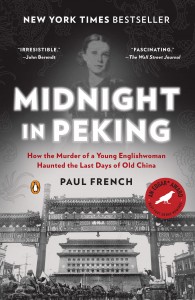Posted: May 7th, 2013 | No Comments »
Here’s a little factoid I didn’t know – from the 192os through to the 1940s many Chinese bank notes issued by the Central Bank of China were manufactured for the Republican treasury by the American Bank Note Company. I have to thanks Helen Wang, the fascinating keeper of the British Museum’s Collection of East Asian coins for that one. I heard her speak the other week at the China in Britain: Archiving Conference at the University of Westminster. Apparently not just the American Bank Note Company, based in Fort Lee (New Jersey), printed money for China but also Waterlow & sons of the UK and De La Rue (also of the UK)
Some Chinese bank notes were indeed printed and produced in China, notably by the Bureau of Engraving and Printing in Beijing. However, even low denomination notes were printed abroad – here below is a one yuan note printed by the American Bank Note Company in 1945 for the Central Bank of China – in 1945 one yuan was effectively worthless due to stagflation.
You learn something new everyday!

Posted: May 6th, 2013 | No Comments »
Felice Beato was one of the first great photographers of China (I wrote about him at some length in my history of foreign journalists in China – Through the Looking Glass). Amazing that still more little known or unknown Beato’s still come to light, but some have and will be auctioned this week in London at Sotheby’s. The up-for-auctions were taken in 1860 and include the only known image of the Summer Palace before it was torched by British and French troops shortly afterwards.
Sadly a little out of my price range but more details in the South China Morning Post here
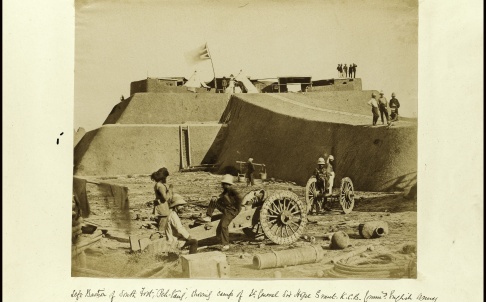
The original caption reads, “left bastion of South Fort – ‘Peh-Tang’ …” Photo by Felice Beato
Posted: May 5th, 2013 | 1 Comment »
 To my mind there’s little doubt that the late WG Sebald’s The Rings of Saturn, the beautiful record of a rambling journey on foot through coastal East Anglia and the various and random thought paths the author was prompted to explore, is one of the best books ever written. Near the delightful town of Southwold Sebald notes the bridge crossing the river Blyth between Walberswick and Southwold which once supported a narrowâ€gauge railway line bearing a train originally built for the Emperor of China. To this day I do not know if this story (which sparks a long and fascinating rumination by Sebald on Dowager Empress Xi Ci, opium, Anglo-Chinese relations, the Taiping) is true. Anyway, I blogged on it here back in July 2011 in some detail. I want to believe the story of the former Emperor’s train is true. If so then it features briefly in the recent documentary that examines Sebald’s Rings of Saturn – Patience (After Sebald) from the director Grant Gee. Discussing Sebald’s China rumination there is footage of the old Chinese Imperial train taking 19th century/early 20th century day trippers to Suffolk on a ride. Fleeting but fascinating if that was indeed once the old Imperial train. Below is, I think, a picture of the train concerned crossing the swing bridge over the River Blyth.
To my mind there’s little doubt that the late WG Sebald’s The Rings of Saturn, the beautiful record of a rambling journey on foot through coastal East Anglia and the various and random thought paths the author was prompted to explore, is one of the best books ever written. Near the delightful town of Southwold Sebald notes the bridge crossing the river Blyth between Walberswick and Southwold which once supported a narrowâ€gauge railway line bearing a train originally built for the Emperor of China. To this day I do not know if this story (which sparks a long and fascinating rumination by Sebald on Dowager Empress Xi Ci, opium, Anglo-Chinese relations, the Taiping) is true. Anyway, I blogged on it here back in July 2011 in some detail. I want to believe the story of the former Emperor’s train is true. If so then it features briefly in the recent documentary that examines Sebald’s Rings of Saturn – Patience (After Sebald) from the director Grant Gee. Discussing Sebald’s China rumination there is footage of the old Chinese Imperial train taking 19th century/early 20th century day trippers to Suffolk on a ride. Fleeting but fascinating if that was indeed once the old Imperial train. Below is, I think, a picture of the train concerned crossing the swing bridge over the River Blyth.

Posted: May 4th, 2013 | No Comments »
It’s official – writer, journalist and all round clever guy Chris Taylor is smarter than me!! I’ve got to admit as he solved my mystery around the book His Chinese Concubine and Graham Greene in my last post. Chris (I think correctly) has identified the book His Chinese Concubine as being by the French author Maurice Dekobra (1885-1973). It’s original French title was Tu Seras Courtisane and published in 1924 in French by Editions Baudiniere and in 1927 in English. Dekobra was extremly well known and popular between the wars and widely translated though he is all but largely forgotten now. He doesn’t appear to have a direct China connection but did serve in India with the French Army.
It does seem Greene was right to use the book as a symbol of his characters depravity, at least mildly. Tu Seras Courtisane was volume 4 of Dekobra’s “manuels pour adultes”. The book’s strapline was “You will be a Courtesan”.
Anyway, I might have the wrong Dekobra book but this all seems highly plausible and thanks to Chris Taylor – in return I can offer him nothing but a plug for his new book – Harvest Season – “When a travel writer retreats to an idyllic valley in the mountains of Southwest China where the weed grows wild on the mountain slopes, he finds his vision of paradise pitted against a new breed of travelers who want to bring the party to town. The scene is set for a clash that will change the valley forever.”
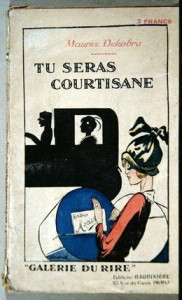
Posted: May 4th, 2013 | No Comments »
References to China pepper the works of Graham Greene although he never visited. Greene, as a young man, fancied a career in China (with British-American Tobacco), dreamt of China and even enrolled in classes to learn Chinese (from Lao She, when he was living and teaching in London in the 1920s, no less). However, he never wrote a China novel (though did write a now lost China play when young that he destroyed – see my post on that here). However, a taste for China never lost him.
Recently I re-read Greene 1936 novel of Greene’s – A Gun for Sale (known as This Gun for Hire in America), filmed in 1941 with Alan Ladd. In the novel Greene’s anti-hero Raven hunts down a man who has double crossed him by the name of Cholmondeley. Greene takes us briefly into Cholmondeley’s office and suggests that the man is corrupt both ethically and morally. One indication of his corruption is that his favourite book is something called His Chinese Concubine. Greene doesn’t tell us the author or the story though we are to believe it is salacious and decadent. The only problem seems to be that His Chinese Concubine never actually existed – it is a figment of Greene’s imagination…or perhaps not? If anyone knows different do let me know?
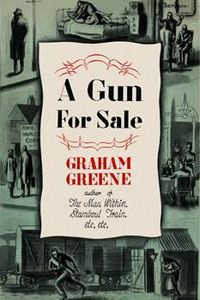 A Gun for Sale first UK edition
A Gun for Sale first UK edition
Posted: May 3rd, 2013 | No Comments »
Those crazy Danes at Beijing Postcards have a new walk they’re offering – “The life and legend of Beijing’s most famous prostitute” (that’s Sai Jinhua, in case you were wondering)

In a fume of opium smoke (or maybe it was just the pollution), we have been walking in the tiny footsteps of the most famous prostitute of Beijing. And now finally after months of preparation we are able to present our new walk: “The life and legend of Beijing’s most famous prostitute: Sai Jinhua, a walk in Beijing’s old redlight district†-the story of a very unlikely hero with tiny Lily feet. For inquiries about the walks on May 5,12 and 26 please contact Bespoke Beijing on this mail:info@bespoke-beijing.com Tickets will be on sale from Monday April 15.
“The life and legend of Beijing’s Most Famous Prostitute: Sai Jinhua, a Walk in Beijing’s Old Red Light District” -the story of a very unlikely hero with tiny Lily feet.Â
A hundred years ago, in a country on the verge of collapse, a woman from the shadows stood up and defended her Chinese countrymen.
Abandoned by the imperial government, and occupied by western  forces looking for  revenge, the fate of Beijing was placed on the narrow shoulders of a common  courtesan.
 But who was this saint like figure? A plain prostitute or a Maria of the East? The  lover of a German general? A Brothel Madam? An opium addict? Or a liar and a  cheat?
Follow us, in the small footsteps of a very unlikely hero with tiny lily feet, through  old opium dens and brothels still standing, when we look for answers.
During this walk we will track down the life of Beijing’s most famous prostitute – Sai Jinhua. We will gain exclusive access to an old brothel, and create a portrait of Dashilan, the more than 600 year old entertainment area and Ba Da Hutong – the old Red Light district.
For inquiries about the walks on May 5,12 and 26 please contact Bespoke Beijing on this mail:
info@bespoke-beijing.com
Tickets will be on sale from Monday April 15.
In connection with the walks we have also created an exhibition of historical pictures of the entertainment district of Dashilan, that will be exhibited at the
Ubi Gallery all through May.
Posted: May 2nd, 2013 | No Comments »
I have long been a lover of the great Hobson-Jobson Dictionary of Anlgo-Indian terms – great to see a new edition. An excellent book to have by the bed for a word or two at random every night – also obviously an essential book should you want to be Amitav Ghosh and write a trilogy full of Hobson-Jobson terms….
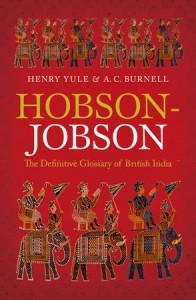
- Hobson-Jobson is a unique lexicon of British India, part dictionary, part social history, a hugely entertaining compilation of words and phrases, here published for the first time with an introduction and notes that shed light on the book’s origins, influence, and cultural significance.
- A classic work of Victorian scholarship, the glossary unlocks the Raj through its language and is the perfect introduction to colonial attitudes and companion to Indian literature from Kipling to Salman Rushdie.
- The introduction traces the book’s creation, reception, and literary influence, revealing its influence on the Oxford English Dictionary and the attitudes that influenced the choice of entries and their treatment.
- Notes explain historical and cultural references and reveal how the glossary both reinforces and challenges Indian stereotypes.
- This selected edition preserves the range and idiosyncratic nature of the original, focusing on entries of particular cultural, historical, and literary interest.
Hobson-Jobson is a unique work of maverick scholarship. Compiled in 1886 by two India enthusiasts, it documents the words and phrases that entered English from Arabic, Persian, Indian, and Chinese sources – and vice versa. Described by Salman Rushdie as ‘the legendary dictionary of British India’ it shows how words of Indian origin were absorbed into the English language and records not only the vocabulary but the culture of the Raj. It encompasses aspects of the history, trade, peoples, and geography of Asia in entries that are at once authoritative and playful. Like the Oxford English Dictionary, Hobson-Jobson included illustrative quotations that were drawn from a wide range of travel texts, histories, memoirs, and novels, creating a canon of English writing about India. The definitions frequently slip into anecdote, reminiscence, and digression, and they offer intriguing insights into Victorian attitudes to India and its people and customs. |
Posted: May 1st, 2013 | No Comments »
The US paperback edition of Midnight in Peking is now out – complete with Edgar Nominee sticker (those are announced Thursday night NYC time)
